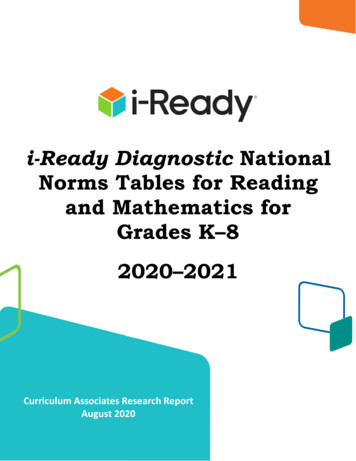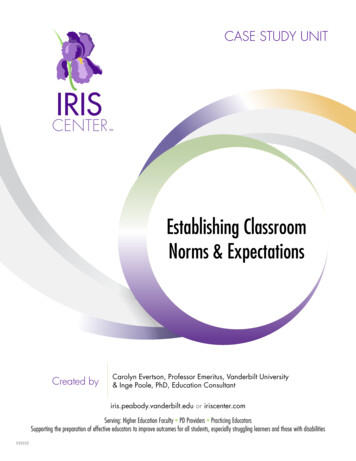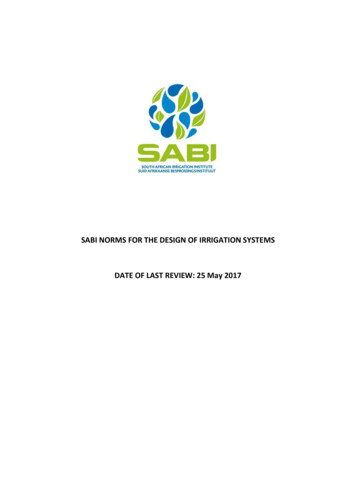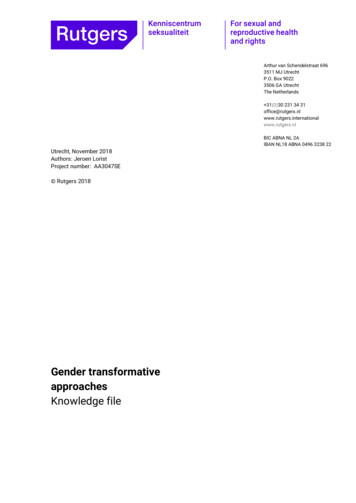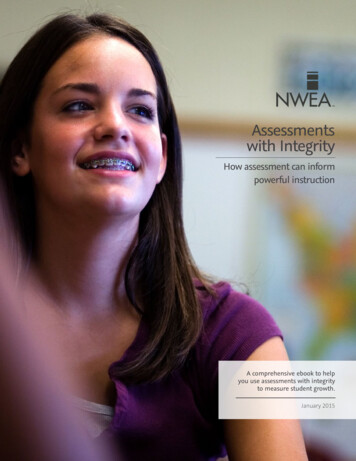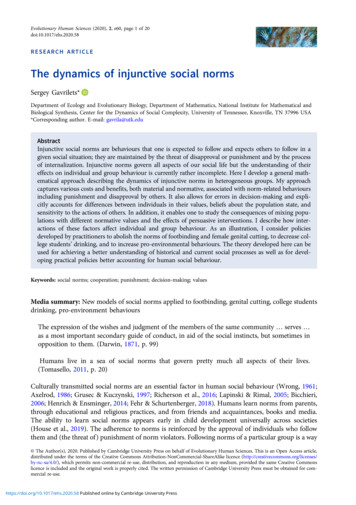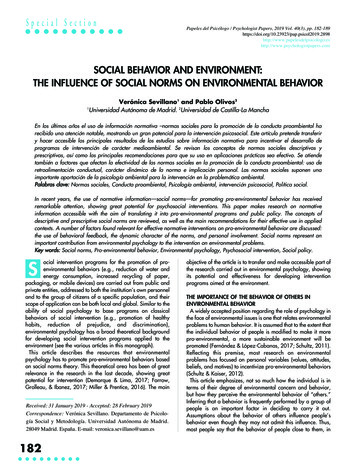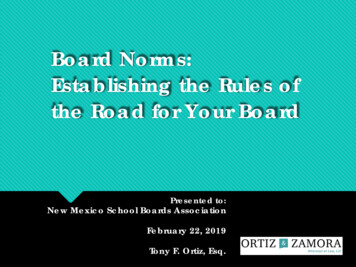
Transcription
Board Norms:Establishing the Rules ofthe Road for Your BoardPresented to:New Mexico School Boards AssociationFebruary 22, 2019Tony F. Ortiz, Esq.
Norms Agreed-upon expectations of one another,particularly in areas where policy is unclear orthere is some need for additional guidance.
Why Do We Need Norms? Establish baseline civility Increase productivity Focus on Mission Wasted resources
Does How You Conduct YourWork Matter for StudentAchievement? From the research, it is clear that school boardsin high-achieving districts exhibit habits andcharacteristics that are markedly different fromboards in low-achieving districts. In the most dramatic examples from thisresearch, scholars compared districts withsimilar levels of poverty and disadvantage todetermine factors that separate highperforming districts from those with lowperformance.
What Makes a BoardEffective?Eight Characteristics of an Effective School Board 1. Effective school boards commit to a vision of highexpectations for student achievement and qualityinstruction and define clear goals toward that vision 2. Effective school boards have strong shared beliefs andvalues about what is possible for students and their ability tolearn, and of the system and its ability to teach all childrenat high levels. 3. Effective school boards are accountability driven,spending less time on operational issues and more timefocused on policies to improve student achievement.
What Makes a Board Effective(continued)? 4. Effective school boards have a collaborative relationshipwith staff and the community and establish a strongcommunications structure to inform and engage both internaland external stakeholders in setting and achieving districtgoals. 5. Effective boards are data savvy; they embrace and monitordata, even when the information is negative, and use it todrive continuous improvement. 6. Effective school boards align and sustain resources, such asprofessional development, to meet district goals. 7. Effective school boards lead as a united team with thesuperintendent, each from their respective roles, with strongcollaboration and mutual trust. 8. Effective school boards take part in team development andtraining, sometimes with their superintendents, to build sharedknowledge, values and commitments for their improvementefforts.
The Best norm is knowingyour role. Section 22-5-4 of the New Mexico Statutesdefines the scope of Board Authority: Focuses on setting policy direction Budgets Limited role in employment matters as a reviewingbody Acquire, lease and dispose of property Except for salaries, contract for expenditure of money Acquire property by eminent domain*Places limitations on the role of the superintendent.
And knowing what roles arenot yours . Section 22-5-14 of the New Mexico Statutes:Superintendent Authority Chief Executive Officer Administer and supervise the school district Employ, fix salaries, assign, terminate anddischarge* This also places limitations on the board.*Statute places general administrative and allemployment functions in the hands of theadministration (HB 212)
Quiz Question on BoardRoles: Authority Over theSuperintendent A board member wants the superintendent to adjust herhandling of a school/policy issue. What questions does that board member need to ask? Do I individually have the authority to request such achange? Where do statute and regulation place the authority foraccomplishing this change? What might be the best way to raise this issue? What will my actions mean for relationships? Am I placing improper pressure on my superintendent? Am I in danger of allegations of conflict of interest orviolations of the Governmental Conduct Act? Norm for handling?
Board Communication:General Norms Board: Help the superintendent anticipate problems Be the “ears and eyes” of the district, not the legs, hands,and mouth. Do not directly communicate with employees orcommunity members regarding confidential problems Remember that the superintendent is your CEO; allinformation should flow through him/her. Litigation Risk Norm: Minimize contact on non-board issues Know what issues don’t belong to you Agreeing to not let employees use the board for complaints
Interpersonal Norms forMeetings Listen more, talk less. No interrupting. Attempt to work with the ideas of others Seek amicable resolution No raised voices Rules for arguing? PUT IT ON THE AGENDA TO SEE BRIEFLY DISCUSSHOW YOU’VE DONE.
Other Meeting Norms Meetings: Limiting Presentations Public Comment (responding) Agendas (who sets, how) Board Comment (at the end of meetings)
Other Norms Board Requests to Administration Site Visits Letters to the editor Fielding criticism about the superintendent
Norms for Board PersonalConflicts Any group of 5 is going to have conflicts. Challenge is not to personalize Challenge is not to air them in front of thepublic What are the impacts for the board? Norms in this area? Ideas: meet privately; mediation; resolvenot to publicly address the other.
Norm: Acting as One Bodyand Supporting the Board Board members only have authority when acting with the board,not as individuals. In giving direction to the administration, the board must act asone body. Speak to the superintendent with one voice, which is themajority on any one issue. The superintendent cannot and should not have to pursue fiveagendas. Do not undermine the board majority decision or theadministration’s attempts to implement. When is your chance to voice objections? What should be your norm/expectation on this? No comments after a board vote to the press or public.
Norms for Social Media Facebook/Instagram posts Can be a form of undermining the board Can be seen as circumventing the board president orsuperintendent’s role as representative Norm options: No posts attacking or questioning the actions or motives ofthe board Focus on positive posts Do not speak for the board
Board Communication:Confidentiality Norms What norms would be wise for protecting confidentiality? Carrying any documents out of executive session Not generating documents in executive session Not speaking of executive session content Others? Examples Where Confidentiality is the expected norm: Employment Discharge Hearings Review of student appeals, high profile conduct, FERPA Leaking Executive Session Discussion Sharing District negotiation positions or taking open positions against the District Possible Negative Consequences of Confidentiality Violations: Civil Rights Claims Undermining the Board/Superintendent/Programs Causing Recusal from Your Participation in Issues/Hearings Harming the District’s legal or financial interests Public Embarrassment for you and the Board
Norms for Union Matters: What are your obligations to the District innegotiations? What are appropriate boundaries? What about communicating with unionrepresentatives in the context of an on-going HRmatter? Any risk of undermining the superintendent or HR? Risk of giving the unions the impression that youcan control HR matters? Norms for communication with the unions?
Norms: Volunteering Employment Barred: Section 22-5-5 A. The members of a local school board shall serve without compensation. B. No member of a local school board shall be employed in any capacityby a school district governed by that local school board during the term ofoffice for which the member was elected or appointed. Volunteering: New Rules Distinguish Between “Regular” and “Spontaneous”Volunteers Regular Volunteers Regulations require interviews, supervision, evaluation, and training Enforcement of Code of Ethics and Professional Standards (including dismissal) Spontaneous Volunteers: The same rules do not apply but such volunteersstill are to be “supervised” by school staff. Potential Problems: Supervisory problems Improper use of influence Public Perception of a Board Member using his/her influence Recommendation: No board members as regular volunteers orspontaneous volunteers. However, more flexibility about serving asspontaneous volunteers. Norms?
What’s the Process forAdoption and Use of Norms? Open Meeting Facilitated discussion of growth areas for the board Creation of a “Norms Statement” Vote to adopt; should aspire to a full board adoption Review at each meeting; a “living document”
Is there an enforcementmechanism? What if a board member simply says, “I’m notgoing to follow that one”? Once a norm is adopted, rogue boardmembers are should be encouraged first, andthen a board can consider more activeenforcement measures such as censuring themember.
Questions?Ortiz & Zamora, LLCtony@ortiz-zamora.com(505) 986-2900
A. The members of a local school board shall serve without compensation. B. No member of a local school board shall be employed in any capacity by a school district governed by that local school board during the term of office for which the member was elected or appointed.


